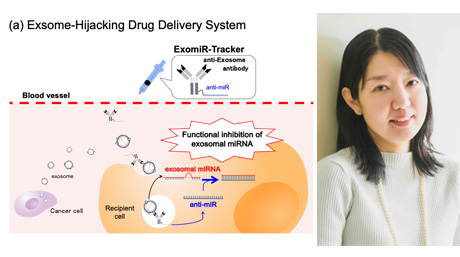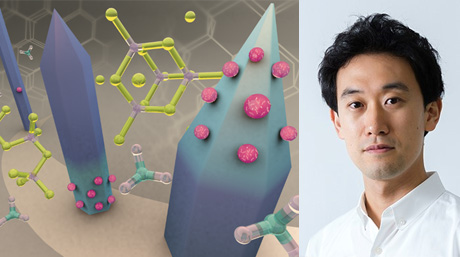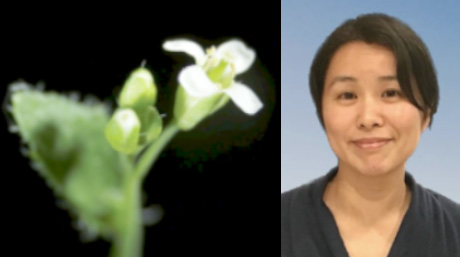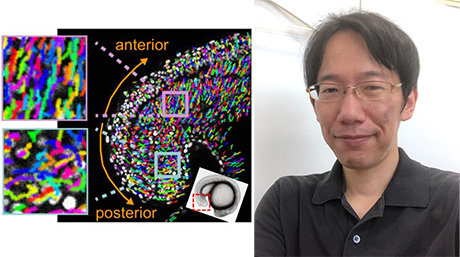Life Science and Technology News
【Labs spotlight】 Kajiwara and Orihara Laboratory
Immunology & Medical Biotechnology
The Department has a variety of laboratories for Life Science and Technology, in which cutting-edge innovative research is being undertaken not only in basic science and engineering but also in the areas of medicine, pharmacy, agriculture, and multidisciplinary sciences.
This "Spotlight" series features a laboratory from the Department and introduces you to the laboratory's research projects and outcomes. This time we focus on Kajiwara and Orihara Laboratory.
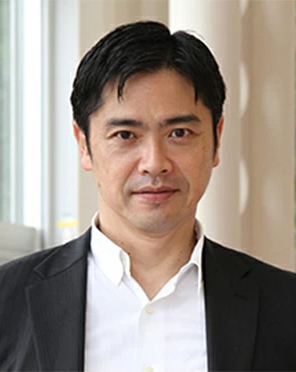
Areas of Supervision
Primary/Science and Technology for health Care and Medicine
Secondary/Life Science and Technology, Human Centered Science and Biomedical Engineering
Visiting Professor Susumu Kajiwara![]()
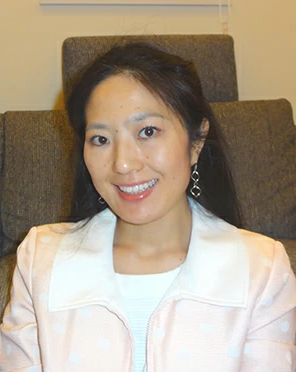
Areas of Supervision
Primary/Science and Technology for health Care and Medicine
Secondary/Life Science and Technology, Human Centered Science and Biomedical Engineering
Associate Professor Kanami Orihara![]()
| Degree | Visiting Professor Susumu Kajiwara:PhD 1993, Tokyo Institute of Technology Associate Professor Kanami Orihara:PhD 2007, Showa University (Doctoral Thesis Research at National Institute for Child Health & Development) |
|---|---|
| Areas of Research | Medical Microbiology, Molecular Biotechnology, Environmental Science. Immunology, Molecular Biology, Chronobiology |
| Keywords | Pathogenicity, Drug resistance, Biofilm, Drug discovery, Biofuel Immunology, Allergic diseases, Infectious diseases, Circadian rhythm |
| Website | Kajiwara and Orihara Laboratory |
Research interest
Visiting Professor Susumu Kajiwara
Our laboratory has studied in the field medical microbiology and environment biotechnology and, in present, focuses on "drug discovery for infectious diseases", "the molecular mechanism of drug resistance and biofilm formation of pathogens", the interaction mechanism between pathogen and the host" and "the efficient utilization of unused bio-resources".
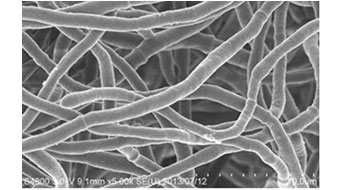
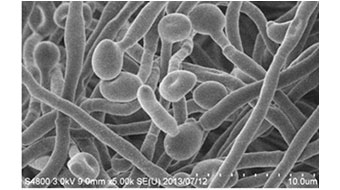
Biofilm formation of pathogenic fungus

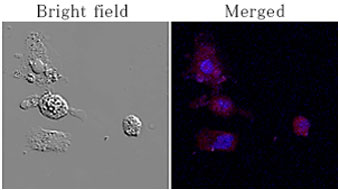
Apoptosis induction of hepatocyte by pathogenic fungi
Associate Professor Kanami Orihara
We are investigating molecular mechanisms involved in immune diseases and animal-microorganism interactions from the viewpoint of circadian rhythm, which is a 24-hour internal clock that locates in almost every single cell in our body. Based on those studies, we are also involved in applying those into new drug development or disease prevention.
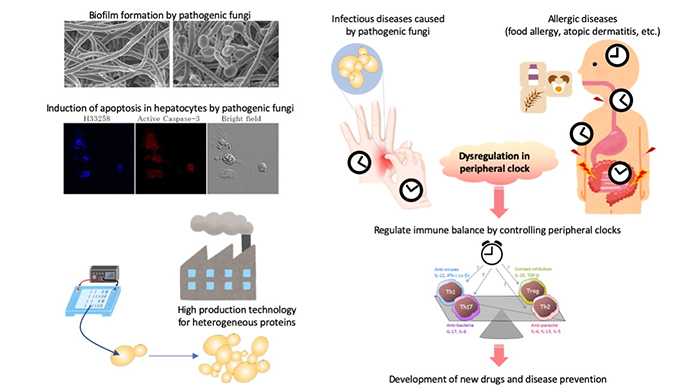
Selected publications
Visiting Professor Susumu Kajiwara
- [1] W. Watanasrisin et al. "Identification and characterization of Candida utilis multidrug efflux transporter CuCdr1p" FEMS Yeast Res. 16 pii: fow042. doi: 10.1093/femsyr/fow042 (2016)
- [2] S. Panapruksachat et al. "Identification and functional characterization of Penicillium marneffei pleotropic drug resistance transporters ABC1 and ABC2" Medical Mycol. 54, 478- (2016)
- [3] W. Juntachai, et al. "Identification of the haemolytic activity of Malassezia species" Mycoses 57, 163-168 (2014)
- [4] S. Youngchim, et al. "The role of L-DOPA on melanization and mycelial production in Malassezia furfur" PLoS One 8, e63764 (2013)
- [5] M. Nagi, et al. "The Candida glabrata sterol scavenging mechanism, mediated by the ATP-binding cassette transporter Aus1p, is regulated by iron limitation" Mol Microbiol. 88, 371-381 (2013)
- [6] C. Yurayart, et al. Antifungal susceptibilities and interpretation analysis of Malassezia pachydermatis and Candida parapsilosis isolated from healthy and dogs with seborrheic dermatitis" Medical Mycol. 51, 721-730 (2013)
- [7] M. Nagi, et al. "The Candida glabrata sterol scavenging mechanism, mediated by the ATP-binding cassette transporter Aus1p, is regulated by iron limitation" Mol Microbiol. 88, 371-381 (2013)
- [8] A. Thong-on, et al, "Isolation and characterization of anaerobic bacteria for symbiotic recycling of uric acid nitrogen in the gut of various termites", Microbes Envrion. 27, 186-192 (2012)
- [9] W. Juntachai, et al. "Purification and characterization of a secretory lipolytic enzyme, MgLIP2, from Malassezia globosa", Microbiology 157, 3490-3497 (2011)
- [10] T. Akao, et al. "Whole-genome sequencing of sake yeast Saccharomyces cerevisiae Kyokai no. 7", DNA Res. 18, 423-434 (2011)
- [11] C. Yurayart, et al. "Comparative analysis of frequency, distribution and population sizes of yeasts associated canine seborrheic dermatitis and healthy," Veterinary Microbiology, 148, 356-362 (2011)
- [12] M. Nagi, et al. "Transcription factors CgUPC2A and CgUPC2B regulate ergosterol biosynthetic genes in Candida glabrata," Genes to Cells, 16, 80-89 (2011)
Associate Professor Kanami Orihara
- [1] Orihara K#, Odemuyiwa SO, Stefura WP, Ilarraza R, HayGlass KT, Moqbel R. Neurotransmitter signalling via NMDA receptors leads to decreased T helper type 1-like and enhanced T helper type 2-like immune balance in humans. Immunology. (Impact Factor, 4.147) 2018 Mar;153(3):368-379. doi: 10.1111/imm.12846. PMID: 28940416.#Corresponding author
- [2] Morita H, Suzuki H, Orihara K, Motomura K, Matsuda A, Ohya Y, Saito H, Nomura I, Matsumoto K. Food protein-induced enterocolitis syndromes with and without bloody stool have distinct clinicopathologic features. J Allergy Clin Immunol. (Impact Factor, 12.485) 2017 Dec;140(6):1718-1721.e6. doi: 10.1016/j.jaci.2017.06.002. PMID: 28629750
- [3] Sato M, Shoda T, Shimizu H, Orihara K, Futamura K, Matsuda A, Yamada Y, Irie R, Yoshioka T, Shimizu T, Ohya Y, Nomura I, Matsumoto K, Arai K. Gene Expression Patterns in Distinct Endoscopic Findings for Eosinophilic Gastritis in Children. J Allergy Clin Immunol Pract. (Impact Factor, 5.429) 2017 Nov-Dec;5(6): 1639-1649.e2. doi:10.1016/j.jaip.2017.03.030. PubMed PMID: 28526277.
- [4] Wada M, Orihara K, Kamagata M, Hama K, Sasaki H, Haraguchi A, Miyakawa H, Nakao A, Shibata S. Circadian clock-dependent increase in salivary IgA secretion modulated by sympathetic receptor activation in mice. Sci Rep. 2017 Aug 18;7(1):8802. doi: 10.1038/s41598-017-09438-0.
- [5] Shoda T, Matsuda A, Nomura I, Okada N, Orihara K, Mikami H, Ishimura N, Ishihara S, Matsumoto K, Kinoshita Y. Eosinophilic esophagitis versus proton pump inhibitor-responsive esophageal eosinophilia: Transcriptome analysis. J Allergy Clin Immunol. (Impact Factor, 12.485) 2017 Jun;139(6):2010-2013.e4. doi: 10.1016/j.jaci.2016.11.028.
- [6] Orihara K, Saito H. 2016. Controlling the peripheral clock might be a new treatment strategy in allergy and immunology. J Allergy Clin Immunol. (Impact Factor, 12.485) 137(4):1236-7. doi: 10.1016/j.jaci.2015.08.054. PubMed PMID: 26560038.
- [7] Shoda T, Matsuda A, Arai K, Shimizu H, Morita H, Orihara K, Okada N, Narita M, Ohya Y, Saito H, Matsumoto K, Nomura I. Sera of patients with infantile eosinophilic gastroenteritis showed a specific increase in both thymic stromal lymphopoietin and IL-33 levels. J Allergy Clin Immunol. (Impact Factor, 12.485) 2016 Jul;138(1):299-303. doi: 10.1016/j.jaci.2015.11.042. PubMed PMID: 26948075.
- [8] Shoda T, Futamura K, Orihara K, Emi-Sugie M, Saito H, Matsumoto K, Matsuda A. Recent advances in the roles of vascular endothelial cells in allergic inflammation. Allergol Int. (Impact Factor, 2.355) 2016 Jan;65(1):21-9. doi: 10.1016/j.alit.2015.08.001. PubMed PMID: 26666487.
- [9] Tanabe K, Kitagawa E, Wada M, Haraguchi A, Orihara K, Tahara Y, Nakao A, Shibata S. 2015. Antigen exposure in the late light period induces severe symptoms of food allergy in an OVA-allergic mouse model. Sci Rep. (Impact Factor, 5.228) 5:14424. doi: 10.1038/srep14424. PubMed PMID: 26419283.
- [10] Anaparti V, Ilarraza R, Orihara K, Stelmack GL, Ojo OO, Mahood TH, Unruh H, Halayko A. J, Moqbel R. NMDA receptors mediate contractile responses in human airway smooth muscle cells. Am J Physiol Lung Cell Mol Physiol. (Impact Factor, 4.721) 308(12):L1253-64. doi: 10.1152/ajplung.00402.2014. PubMed PMID: 25888577.
- [11] Mou Z, Liu D, Okwor I, Jia P, Orihara K, Uzonna JE. 2014. MHC class II restricted innate-like double negative T cells contribute to optimal primary and secondary immunity to Leishmania major. PLoS pathogens. (Impact Factor, 7.562) 10(9):e1004396. doi: 10.1371/journal.ppat.1004396. PubMed PMID: 25233487.
- [12] Ilarraza R, Odemuyiwa S.O, Orihara K, Arizmendi N, Moqbel R. Eosinophils as Immune modulators; Role of Indoleamine 2,3 Dioxygenase (IDO) and Tryptophan Catabolites. In Eosinophils in Health and Disease; 16.4 621-34; Editors: Lee J.J., Rosenberg H.F.; Academic Press, 2012-12-17. ISBN: 012394385X, 9780123943859.
- [13] Morita H, Nomura I, Orihara K, Yoshida K, Akasawa A, Tachimoto H, Ohtsuka, Y, Namai Y, Futamura M, Shoda T, Matsuda A, Kamemura N, Kido H, Takahashi T, Ohya Y, Saito H, Matsumoto, K. Antigen-specific T-cell responses in patients with non-IgE-mediated gastrointestinal food allergy are predominantly skewed to T(H)2. J Allergy Clin Immunol. 131(2):590-2 e1-6. doi: 10.1016/j.jaci.2012.09.005. PubMed PMID: 23083674.
- [14] Orihara K, Dil N, Anaparti V, Moqbel R. What's new in asthma pathophysiology and immunopathology? Expert Rev Respir Med. (Impact Factor, 2.716) 4(5):605-29. doi: 10.1586/ers.10.57. PubMed PMID: 20923340.
- [15] Yagami A*, Orihara K*, Morita H, Futamura K, Hashimoto N, Matsumoto K, Saito H, Matsuda A. IL-33 mediates inflammatory responses in human lung tissue cells. J Immunol. (Impact Factor, 4.985) 185(10):5743-50. doi: 10.4049/jimmunol.0903818. PubMed PMID: 20926795. *Equally contributed authors.
- [16] Futamura K*, Orihara K*, Hashimoto N, Morita H, Fukuda S, Sagara H, Matsumoto K, Tomita Y, Saito H, Matsuda A. beta2-Adrenoceptor agonists enhance cytokine-induced release of thymic stromal lymphopoietin by lung tissue cells. Int Arch Allergy Immunol. (Impact Factor, 2.87) 152(4):353-61. doi: 10.1159/000288288. PubMed PMID: 20185927. *Equally contributed authors.
- [17] Matsuda A, Orihara K, Matsumoto K, Saito H. Asthmatic airway remodeling based on changes in the structure and function of pulmonary microvessels. Kokyu 2009;28(5):547-9. (Japanese)
- [18] Orihara K, Morita H, Yagami A, Kajiwara N, Nakae S, Matsumoto K, Saito H, Matsuda A. TH2 cytokines potently induce an appetite-stimulating peptide, melanin-concentrating hormone, in human vascular endothelial cells. J Allergy Clin Immunol. (Impact Factor, 12.485) 124(3):612-4, 4 e1-2. doi: 10.1016/j.jaci.2009.04.039. PubMed PMID: 19541358.
- [19] Enomoto Y, Orihara K, Takamasu T, Matsuda A, Gon Y, Saito H, Ra C. Okayama Y. Tissue remodeling induced by hypersecreted epidermal growth factor and amphiregulin in the airway after an acute asthma attack. J Allergy Clin Immunol. (Impact Factor, 12.485) 124(5):913-20 e1-7. doi: 10.1016/j.jaci.2009.08.044. PubMed PMID: 19895983.
Contact
Visiting Professor Susumu Kajiwara
Room 1018, J3 building, Suzukakedai campus
E-mail : kajiwara.s.aa@m.titech.ac.jp
Associate Professor
Room 1018, J3 building, Suzukakedai campus
E-mail : orihara.k.ab@m.titech.ac.jp
*Find more about the lab and the latest activities at the lab site![]() .
.
*May 1, 2025:Some of the content has been updated with the latest information.

